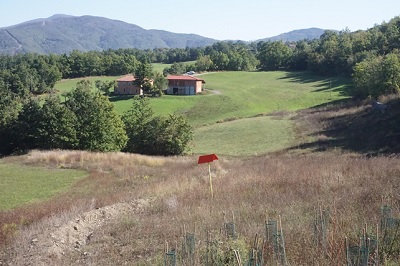Ca’ Nova di Albareto (PR)
Archaeological Excavation at the Bronze Age Site

Coordinator/ Mission Manager
Cristiano Putzolu
Field of research and classifications
Archaeological disciplines from prehistory to the medieval period
VRA: area 10
ERC: SH 6, The study of the human past: archaeology, history, and memory
SDG: 4) Quality education; 11) Sustainable cities and communities; 15) Life on land
Prevalent type of public engagement
Organization of initiatives to promote, consult, and share research
Description
Activities are planned to communicate the progress of the research and its results through social media and the DiSCi website. In addition, open meetings with the public are envisaged in the belief that the historical heritage of the area where the research is conducted should be shared primarily with its residents. During the four-week excavation period, the plan is to hold four meetings—two at the site and two in the spaces dedicated to the cartographic and materials laboratory. These meetings will not only allow interested parties to learn about the history of the mountainous environment in which they live but also to gain familiarity with the methods we use to reconstruct this history. At the end of the campaign, a meeting with the local population will be organized to report on the preliminary results of the excavation that has just been concluded. The purpose of these public meetings is to provide different age groups (primary school students, secondary school and university students, adults) with a general overview of the environment and the different ways of life in an area (the Parmesan Apennines of the 2nd millennium BC) where settlement choices were focused on making the most of environmental resources.
As an additional means of sharing research results with the population, a temporary exhibition is also planned showcasing the most significant artifacts and providing appropriate educational support. The exhibition will be held in a suitable location in the area.
The research and subsequent activities to promote and share the research results are focused on a period in which the relationship between human communities and their surrounding environment was crucial, and areas such as the mountains (which today are at risk of depopulation in favor of urban centers) played a crucial role the importance of which it would be useful to convey to the new generations.
Locations and Periods
The public meetings will take place in suitable spaces provided by the local administration.
The period will coincide with the excavation campaign, which has not yet been defined but will take place between late spring and summer 2023.
Collaborations and Partners
In addition to the professors and researchers from DiSCi, the research team also intends to involve specialists from other universities (such as the Chair of Prehistoric Ecology at the University of Milan, Palynology at the University of Modena and Reggio Emilia, and Geoarchaeology at the University of Padua), who will be invited to participate in the activities to promote, consult, and share the research. The communication activities carried out via the web and social media channels will be entrusted to an external professional who will collaborate with students from the research team.
Objectives and Engaged Audiences
A preliminary meeting with the Biodistrict of Alte Valli, a consortium of municipalities representing an area spanning Emilia Romagna, Tuscany, and Liguria, confirmed that local civil society is interested in a history of the area that encompasses aspects of paleoenvironmental reconstruction. Therefore, the objective is to provide current inhabitants of the Apennines, primarily primary and secondary school students but also adults, with a framework of knowledge about the mountainous environment, its specific features, and the crucial role it played during the 2nd millennium BC.
Impact and Evaluation Tools
The planned meetings are aimed at the local population and will likely take place when schools have finished for the summer break. Therefore, it is estimated that a total of about one hundred people would be involved. There is no data available to estimate the expected number of web and social media views.
The activity has not yet begun, as the first campaign is being organized to take place in late spring/summer 2023. However, a dedicated university website will be created to monitor access to the excavation campaign and related activities (including outreach efforts). Alongside the website, communication regarding the activities carried out will be posted on social media platforms through the collaboration of a social media communication professional on the research team. Finally, the number of participants in the meetings will be an indicator of the success of the initiative.
Keywords
Environment, Apennines, Mountains